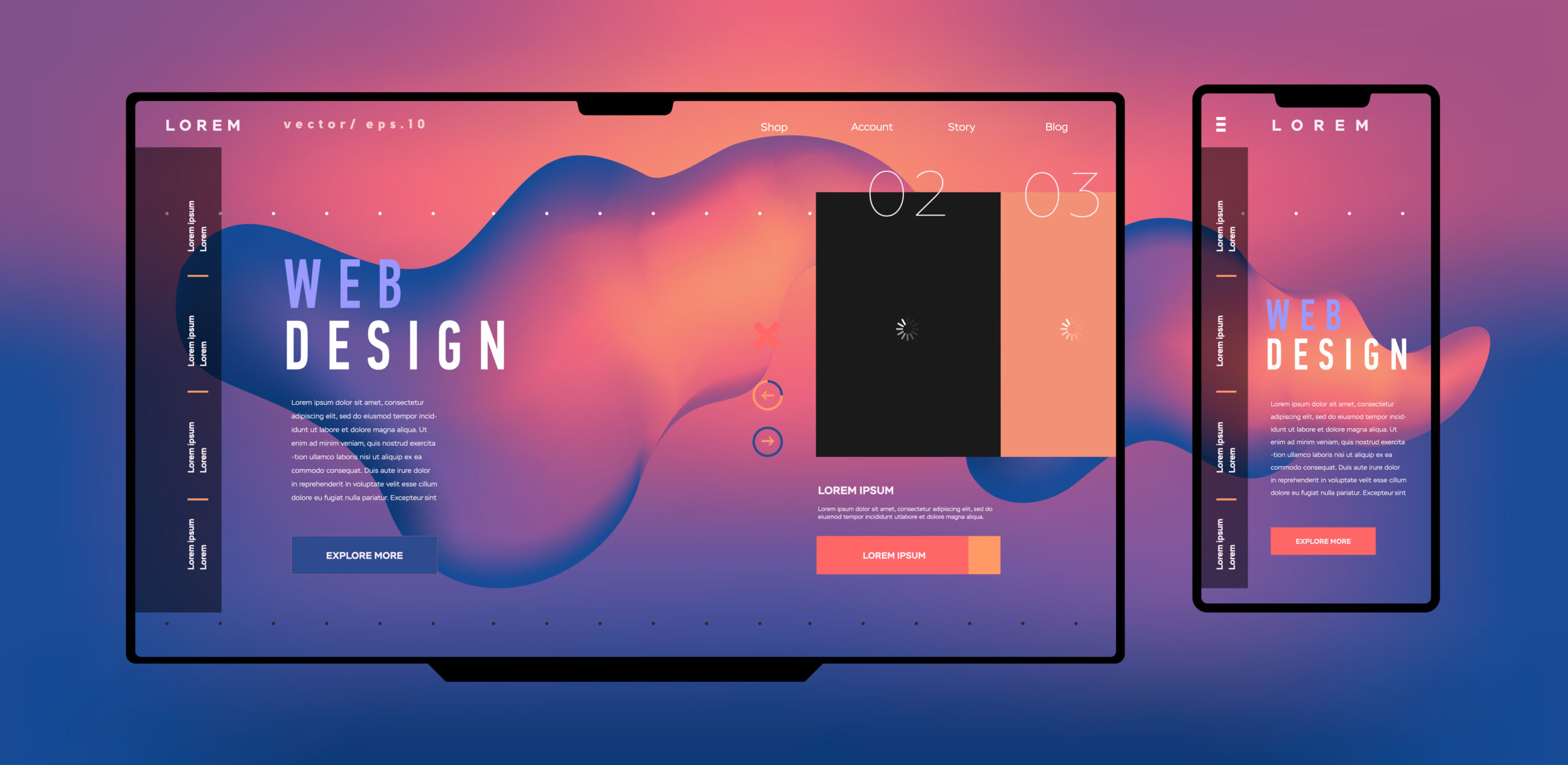Vital Tips for Enhancing Your Online Visibility With Web Design
In today's digital landscape, web design plays a crucial function fit an on-line presence. A well-structured website can significantly improve user interaction and brand identity. Secret components such as user experience, mobile optimization, and lots rate are important factors to consider. Comprehending these components can make a considerable difference. What certain approaches can be used to successfully execute these design principles? Discovering these facets will certainly expose a lot more regarding enhancing on the internet exposure.
Prioritize User Experience (UX)
When designing a website, focusing on user experience (UX) is essential for making certain that site visitors can browse the site effectively and involve with its web content. A well-structured design aids customers find info swiftly, minimizing stress and enhancing the possibility of return visits. Secret components such as instinctive navigation, clear phone call to action, and aesthetically appealing design add substantially to a favorable UX.
In addition, consistency in layout components, consisting of color systems and typography, cultivates experience and count on. Interest to tons times is additionally vital; fast-loading pages maintain individuals, while hold-ups can cause high bounce prices. Incorporating comments mechanisms, such as surveys or get in touch with types, enables businesses to understand user needs and improve appropriately. Ultimately, an emphasis on UX not just boosts site visitor contentment yet additionally supports the general goals of the web site, driving conversions and developing a devoted audience.
Optimize for Mobile Tools
In today's digital landscape, maximizing for mobile tools is vital for reliable web design. This includes carrying out receptive style, guaranteeing quickly packing times, and including touchscreen navigation functions. These components jointly improve user engagement and fulfillment on mobile systems.
Receptive Design Value
Responsive layout stands as a keystone of contemporary web growth, guaranteeing that internet sites operate seamlessly across different gadgets, especially cellphones. As smart device usage remains to climb, customers anticipate a consistent experience no matter display size. A responsive layout adapts the layout, images, and performances to various gadgets, improving use and engagement. This flexibility is vital, as it permits companies to get to larger target markets without the demand for different mobile websites. Furthermore, online search engine prefer receptive websites in their positions, making it important for visibility in a crowded digital landscape. Ultimately, purchasing responsive layout is not merely about looks; it is a strategic approach that enhances user experience and drives possible conversions.
Quick Loading Times
Quick loading times are necessary for maximizing mobile phones, as customers progressively expect instantaneous access to information - Website Design Agency. An internet site that lots quickly boosts user fulfillment and minimizes bounce prices. Mobile individuals usually access websites on-the-go, where sluggish packing can bring about frustration and abandonment. To accomplish quick packing times, web developers should prioritize image optimization, decrease HTTP requests, and use caching techniques. In addition, using material distribution networks (CDNs) can better improve lots speed by distributing material closer to users. Streamlining the website's code and leveraging asynchronous packing for manuscripts can likewise add to enhanced performance. Eventually, a fast-loading web site not only sustains user interaction but also favorably influences search engine positions, making it an important aspect of efficient web design
Touchscreen Navigation Includes
A smooth user experience on mobile phones greatly counts on efficient touchscreen navigation functions. Developers must focus on user-friendly formats that fit gestures such as tapping, swiping, and pinching. Big, conveniently tappable switches minimize user disappointment and enhance functionality, permitting for smoother interactions. On top of that, integrating aesthetic responses, such as highlighting buttons when pressed, can greatly improve user involvement.
Applying a regular navigating structure throughout pages aids in user orientation, making it less complicated for visitors to find info. In addition, receptive design assurances that components resize appropriately for different display dimensions, keeping use. Ultimately, reducing the requirement for scrolling and providing fast access to key functions will certainly help users navigate efficiently, ultimately cultivating a favorable online experience.
Emphasis on Load Rate
While web site appearances and performance are important, focusing on lots speed is essential for keeping visitors and boosting total user experience. Study shows that individuals expect websites to fill in under three seconds; anything longer can cause raised bounce prices. A slow-loading website discourages customers and decreases the chance of maintaining their passion.
To enhance tons speed, internet designers should optimize picture sizes, reduce HTTP demands, and leverage web browser caching. Furthermore, using content shipment networks (CDNs) can distribute web content a lot more effectively throughout different locations, resulting in quicker access times.
Furthermore, visite site getting rid of unneeded plugins and scripts can minimize tons times considerably. Consistently examining website rate using devices like Google PageSpeed Insights helps determine locations for enhancement. By concentrating on tons rate, companies can develop a more seamless searching experience, inevitably encouraging user involvement and boosting conversion prices. Speed is not simply a technological element; it's a crucial element of user satisfaction.
Carry Out Clear Navigating
Effective navigation works as the backbone of an user-friendly web site, guiding visitors seamlessly via its content. A well-structured navigating system assures that users can conveniently locate the info they seek, improving their overall experience. It is very important to prioritize simpleness; menus should be uncomplicated, with clear tags that precisely represent the corresponding web pages.
Organizing content right into rational classifications can likewise promote quicker access, assisting users navigate without really feeling bewildered. Carrying out breadcrumb trails permits site visitors to track their journey via the website, providing context and making it possible for very easy backtracking.

Utilize Engaging Visuals
Integrating interesting visuals can considerably improve a website's allure and efficiency, as they capture user interest and convey information more dynamically than text alone. Top quality images, video clips, and infographics can produce a memorable user experience, motivating visitors to spend even more time on the site. Visuals can click reference additionally assist in storytelling, enabling brands to communicate their message better and stimulate psychological reactions.
Using a constant color palette and layout style can furthermore reinforce the overall visual influence. Interactive elements, such as sliders or computer animations, can likewise engage customers, making navigating much more delightful. Visuals must be enhanced for quick loading times to stop frustrating delays that can drive users away. Ultimately, a thoughtful combination of involving visuals can not just improve aesthetic allure yet also enhance user understanding and retention, resulting in higher interaction and conversion rates.
Keep Consistent Branding
Preserving regular branding across a website is necessary for establishing a strong identity and promoting trust fund with visitors. This uniformity incorporates various aspects, consisting of color pattern, typography, logos, and imagery. By making sure that these parts align with the brand's core message, businesses can produce a natural experience that reverberates with users.
A distinct brand identification not just improves acknowledgment yet also reinforces client commitment. They are extra likely to perceive the brand name as reputable and professional when visitors experience a consistent look and feel. Irregular branding, on the various other hand, can cause complication and decrease the general user experience.

Include SEO Finest Practices
Producing a solid brand identity is just component of the equation for an impactful web site; optimizing for search engines is just as important. Including SEO best methods assurances that a website places higher in search engine results, making it extra noticeable to potential clients. This includes using pertinent key words throughout the website's content, including titles, headers, and meta summaries, which assist internet search engine recognize the site's function.
Furthermore, maximizing images with alt tags and ensuring quick packing times boosts user experience and lowers bounce prices. A mobile-friendly style is important, as more users access the internet using mobile devices. Interior linking between pages can enhance website navigating and maintain visitors engaged much longer. Moreover, consistently updating web content with fresh details signals to online search engine that the website is read here active, which can positively affect rankings. By integrating these techniques, companies can considerably enhance their online visibility and draw in even more website traffic to their internet sites.
Regularly Asked Concerns
Just How Can I Gauge the Performance of My Web Design?
To measure web design efficiency, one can examine user involvement metrics, screen conversion prices, conduct A/B screening, gather user comments, and analyze site performance with analytics tools, guaranteeing constant renovation and positioning with user needs.
What Tools Can Aid With Web Design Analytics?
Google Analytics, Hotjar, and Adobe Analytics are effective devices for web design analytics. Web Design Agency. These platforms make it possible for individuals to track visitor habits, examine traffic resources, and action involvement, offering valuable insights for maximizing layout effectiveness and user experience
How Typically Should I Update My Internet Site Layout?
An internet site design must be updated a minimum of each year to stay appealing and pertinent. Nonetheless, frequent updates might be necessary based on user feedback, progressing trends, or considerable changes in service goals or offerings.
What Are the Usual Web Design Errors to Prevent?
Usual web design mistakes include overly chaotic designs, bad navigating, inconsistent branding, ignoring mobile responsiveness, slow loading times, and overlooking user experience. Avoiding these pitfalls can greatly enhance a site's performance and user involvement.
Exactly How Can I Guarantee My Internet Site Is Obtainable to Every person?

Focus On User Experience (UX)
When designing a creating, web site user experience (UX) is essential for ensuring that making sure can site visitors the browse effectively and engage with involve content. A website that loads promptly enhances user fulfillment and lowers bounce rates. While website aesthetic appeals and performance are vital, focusing on lots speed is critical for maintaining site visitors and improving overall user experience. A mobile-friendly layout is necessary, as more individuals access the net using mobile tools. Typical internet layout blunders consist of overly messy layouts, inadequate navigating, irregular branding, ignoring mobile responsiveness, slow-moving loading times, and disregarding user experience.